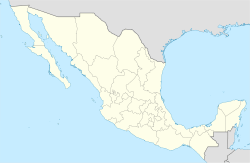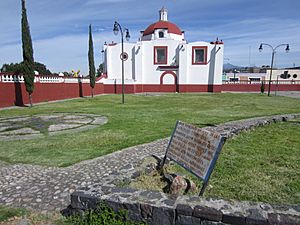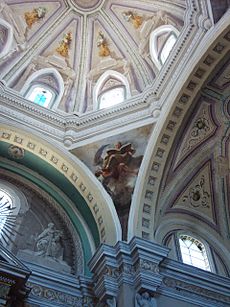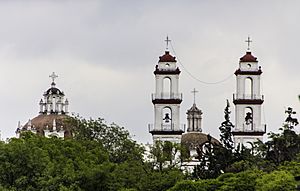Church of Analco, Puebla facts for kids
Quick facts for kids Church of Analco, Puebla |
|
|---|---|
| Temple of the Holy Angel Custodian of Analco | |
|
Templo del Santo Ángel Custodio de Analco
|
|
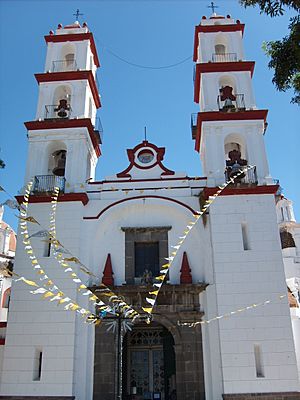
The church's exterior in 2011
|
|
| 19°02′19.6″N 98°11′34″W / 19.038778°N 98.19278°W | |
| Location | Analco, Puebla |
| Country | Mexico |
| Denomination | Roman Catholic |
| History | |
| Status | Church |
| Founded | 1619 |
| Founder(s) | Alonso de Rivera Barrientos |
| Dedication | Santo Ángel de la Guarda |
| Architecture | |
| Style | Baroque |
| Years built | 1618–1632 |
| Specifications | |
| Materials | Masonry and stone |
| Administration | |
| Archdiocese | Roman Catholic Archdiocese of Puebla de los Ángeles |
The Church of Analco is a historic Roman Catholic church in Puebla, Mexico. Its full name is the Church of the Holy Angel Custodian of Analco. It is dedicated to the Holy Guardian Angel of Puebla. This church is found in Analco, one of Puebla's oldest neighborhoods. Many indigenous people live here.
History of the Church
The Church of Analco was built where a smaller, older building once stood. This older building was a hermitage, a small place for prayer. It was built in 1560 by the Mixtec and Tlaxcala indigenous groups. They dedicated it to the souls in purgatory.
In 1618, a leader named Alonso de Rivera Barrientos tore down the old hermitage. He wanted to build a new, bigger church. This new church was dedicated to the guardian angel of Puebla. The city council officially opened the church in 1619.
The number of people living in Analco grew. Both indigenous and Spanish people needed more space. In 1626, a bridge was built to connect the church to the main city. In 1627, a group of Franciscans (a type of religious order) started to manage the church.
Later that year, on October 13, 1627, Bishop Bernardo Gutiérrez de Quirós arrived. He made the church a "parish" for Analco. This meant it became a more important church for the local community. To celebrate, the community started to fix up the church. Spanish residents gave money, and the native people of Analco worked hard.
In 1640, Bishop Juan de Palafox y Mendoza made some changes. He put the first diocesan priest, Fernando Díaz de Talavera, in charge. This meant the church was now directly under the bishop's control. In 1767, a new chapel was finished inside the church. It was dedicated to the Virgin of Tzocuilac.
Church Design and Art
The Church of Analco is built in a special style called indigenous Baroque. It uses cut stones and a type of cement called mortar. On the front of the church, called the façade, you can see a main figure. It is the archangel Michael.
Above the front door, there is a Latin message. It says: ANGELE SANCTE DEI SIT SEMPER CUSTOS MEI. This means, "Holy Angel of God, always guard me." Two tall towers stand on either side of the front. The south tower was built in the 1600s. The north tower was added later, in the late 1700s.
The inside of the church has one main open space, called a nave. It also has a simple crossing area. The church has a dome without a drum (a round wall under the dome). This dome is decorated with carved pictures of archangels. They look like Roman soldiers.
The original fancy altars, called retables, were changed in the 1800s. New ones were put in that followed a Neoclassical style. The main altar shows a guardian angel protecting a small child.
On one side of the church, there is a chapel called the Chapel of Veronica. It has a sculpture of Jesus falling three times. This sculpture was made by Manuel de la Paz. Next to this chapel is the baptistery, where baptisms happen. It has a beautiful iron screen from 1780.
On the other side, you'll find the chapel dedicated to the Virgin of Tzocuilac. This chapel has an even bigger and fancier iron screen. It was given by Roque Jaramillo de Illescas in 1767. A legend says that a painting of the Virgin Mary on a wall was saved by a miracle. This chapel also has a special painting that looks 3D, called a trompe l'oeil.
Amazing Discoveries
In 1999, an earthquake damaged the church towers. Workers started to fix and restore them. During this work, they made an exciting discovery! People thought the south tower was solid and just for decoration. But it turned out to be hollow inside! It was used in the 1600s and 1700s.
Inside the hollow tower, they found many things. They found parts of a spiral staircase that led to the bells. They also found human and animal bones. Plus, there was a hidden collection of old objects. These objects included:
- Pieces of majolica (a type of pottery with colorful glaze)
- Talavera pottery (a famous type of Mexican ceramics)
- Other ceramics
- Red clay tiles with a shiny glaze
These items were from the late 1600s to the early 1800s. They also found old leather shoes, glass, stone objects, wood, and baskets. These finds showed that the tower was used until the late 1700s or early 1800s.
The restoration also uncovered a painting on a gray stone slab. It might be of the Immaculate Conception or the Virgin of the Light. Experts think a Spanish-trained artist created it in the mid-1800s. The stone slab was broken in two pieces. It probably came from a tomb. This is because the church's front yard was used as a cemetery until the 1800s.
See also
 In Spanish: Templo de Analco (Puebla) para niños
In Spanish: Templo de Analco (Puebla) para niños


